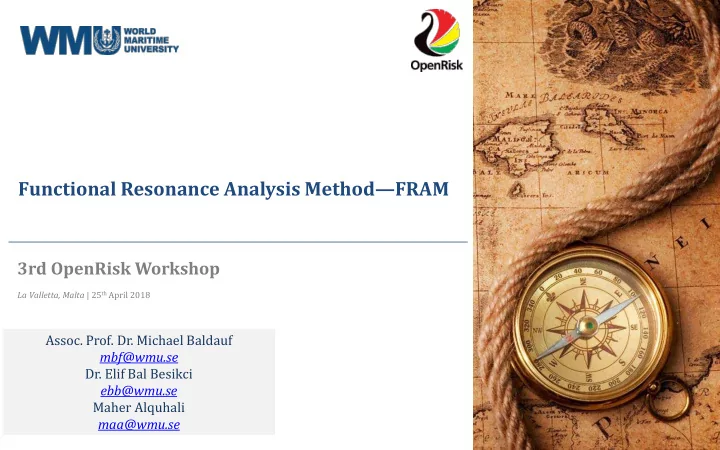

Functional Resonance Analysis Method—FRAM 3rd OpenRisk Workshop La Valletta, Malta | 25 th April 2018 Assoc. Prof. Dr. Michael Baldauf mbf@wmu.se Dr. Elif Bal Besikci ebb@wmu.se Syed Raza Ali Mehdi Maher Alquhali rm@wmu.se maa@wmu.se
o Background: • PhD, Maritime Transportation Engineering, Istanbul Technical University • Oceangoing Chief Officer o Current Status: • Technical Officer OpenRisk Project • Assistant Professor Istanbul Technical University o Research Areas: • Maritime safety and transportation • Risk, Safety & Reliability Assessments • Human factor at sea • Maritime energy management and energy efficiency Introduction | 2
Functional Resonance Analysis Method—FRAM Background FRAM: is a qualitative tool that was developed by Erik Hollnagel in the early-to-mid 2000s as • part of the ‘Safety-II’ ideology; The ‘Safety-II’ way-of-thinking is in stark contrast with ‘Safety-I’ thinking traditional risk • assessment and accident investigation methods Different sources of success and failure: Safety-I (a) and Safety-II (b) Introduction | 3
FRAM Background o FRAM uses a non-linear accident model o FRAM has been already used by high-risk industries such as aviation, maritime, medical and the nuclear sectors, they have explored the use of it in different contexts over the last decade. Introduction | 4
FRAM-Principles o The FRAM relies on four basic principles (Hollnagel, 2012): Principle of equivalence of successes and failures FRAM Principle of Principle of approximate emergence Principles adjustment Principle of functional resonance Introduction | 5
FRAM- Process o FRAM has 4-step process: Step 1: Identification and description of system’s functions Graphical representation of a FRAM function. Introduction | 6
FRAM- Process Step 2: Identification of performance variability Step 3: Aggregation of variability Step 4: Management of variability Introduction | 7
FRAM-Input o The input for a FRAM model is sourced from several interviews and observational studies , as well as from the analysis of past incident reports or even work manuals , in order to obtain the aspects: time, control, and resource constraints that people face during different tasks, as well as an insight about the necessary pre-conditions. Introduction | 8
FRAM-Output Introduction | 9
FRAM- Strenghts and Limitations Strenghths Limitations It requires significant expertise; It promotes holistic systemic thinking; • • It does not directly provide probability It helps end-users to overcome the • • and consequence values, or any issues such as blame culture, which quantitative values for that matter – are typically associated with deep which makes it an abstract tool for the root-cause analyses; purposes of risk assessment; It is a generic tool which can be used • It is highly sensitive to end-users’ to model any conceivable activity, • perceptions, which can raise concerns system or process. about model validity; Introduction | 10
Thank You!
Recommend
More recommend